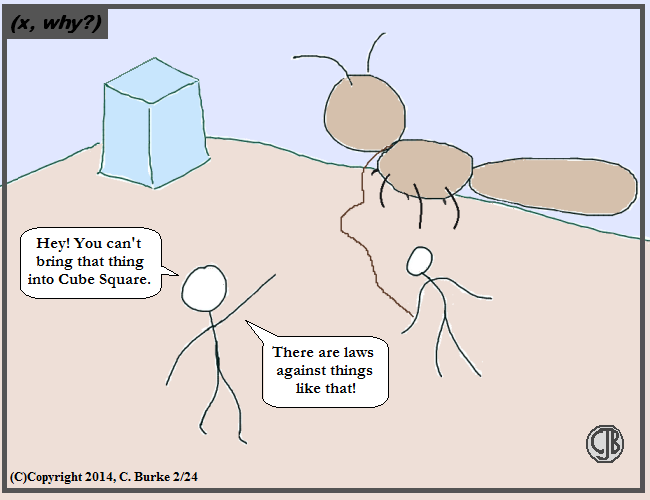
Friday, February 28, 2014
Bonus Blog-Only Comic: Square Root of the Answer

Thursday, February 27, 2014
Kidsongs Flowcharted: Ears
What if they do? What if I can?
What if they don't? What if I can't?
The song never tells us!

Monday, February 24, 2014
Cube Square
When they tell you that you can't have giant ants, they mean that you can't mutate a regular ant into a giant one. But could they evolve that way on their own?
Actually, that was the point of a SF story I read years ago, I think, in one of the Dangerous Visions anthologies.
This isn't the first time giant ants have appeared in (x, why?). For more giant ants, check out Ants vs. Spiders.
And then there are these:


Tuesday, February 18, 2014
Don't Blink
Congratulations to my daughter on her first ''big girl'' job.
Don't blink. Blink and you miss it. Good luck.

Monday, February 17, 2014
My Short Short-Story-Writing Writing Career: Car Wars
That was the good news. Then came the bad news: that's the only short story that I ever had published that wasn't self-published. I had a few of those. In fact, my friend Rob Garitta and I put out our own fiction fanzine, set primarily in the Car Wars universe of Steve Jackson Games. We kept it up for a little over a year. We didn't get a lot of renewals from our subscribers. But that's not the point of this post.
The funny thing is this: why am I talking about writing science-fiction stories set in a post-apocalyptic America in my math blog? (Other than because tooting own's horn never goes out of style when you're the one with the horn.)
It's because it was a numbers story from the very beginning.
Let me explain: Car Wars was a board game, but not in the traditional sense. There was a board, but you were free to move about the area, anywhere inside the perimeter of the arena. (Okay, worked in two vocabulary words.) Your piece on the board was basically a demolition car with automated weapons attached. After you played the game a few times with the stock cars that the designers included, if you looked in the back, there were rules for constructing your own car. It was a shopping list of menu after menu and table upon table. And it wasn't just addition and subtraction. There was a multiplier to increase the maximum weight of your chassis by 10% or 20%. There were power factors that told you how you could calculate your car's acceleration. There were limits to watch out for: too heavy and your car couldn't move, assuming that the chassis could support the weight. Everything had to fit in the given number of spaces and there was a limit to how much could be piled onto one side of the car.
Car Wars was a game of continuous movement broken down into a series of instants. There were trade-offs required for simple game-play (e.g., less complexity = more fun). As a result, players realized that they had trade-offs of their own. This gave rise to the min-maxers, players who would calculate in advance where the breaks were, what was the highest amount that they could before losing a benefit (such as higher acceleration). Did the design merit an extra-heavy chassis? Was the engine going to haul all that weight? How many bonuses do I need to fire before I max out? Is this weapon cost-effective and worth the weight?
Well, my story "Don't Kill the Messenger" was born out of a math riddle. What could you do if you put the biggest engine into the smallest car. The result was that you had room for a driver and nothing else: no guns, no cargo, zip, nada, nothing. But with an engine that big, it had a lot of hauling power. Question 2: could this car pull a tractor-trailer? Answer: not a chance, BUT it could pull just the tractor ... maybe. I had to go through the AADA Vehicle Guide to find a tractor just under the limit -- otherwise, I would've designed one. I did find one, and it had a ramplate. Well that was just another little detail for the story.
The first draft of this story was written when I was in college and was working as a messenger on Wall Street. I didn't drive or even ride a bike. I was on my feet most of the day. However, I had great ideas for using the messenger room as a starting point and the title "Don't Kill the Messenger" was there from the beginning. All the details fell into place just from the vehicles I'd selected and the background of the main character. And the math.
So all that number-crunching paid off for me with a sale in late 1988. I guess I really did do something with all that math after high school.
P.S. There's more to the writing story, and I may get back to it.
Thursday, February 13, 2014
Quiz Snows
Any resemblance to any fast food place is purely in your mind.
To be fair, I did elaborate on the definition of the word 'unless' to those who were still paying attention.
Giving a quiz when it snows isn't logically inconsisent... It's just really silly as 70-90% of my class will be absent.

Tuesday, February 04, 2014
What Did One Pencil Say to the Other?
Two comics, two days in a row? I'm trying to get the lead out!

Monday, February 03, 2014
Spring Is Coming ... Sooner or Later
The Celts called it "Imbolc" (the 'b' is silent, so some other possible puns went South), the time when we moved out of winter and into spring. Our co-ordinates on the elliptical orbit is left as an exercise to the reader.























